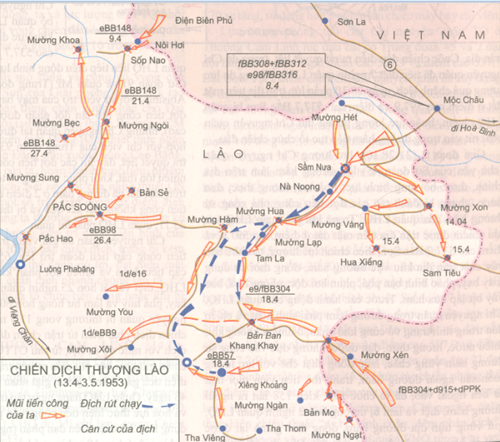As scheduled, the French divided the Upper Laos into two parts: Mountains and plains. In these areas, they strengthened forces. In Xam Neua town of Houaphanh province, the French kept about 2,500 troops and an artillery company. In Xieng Khouang province, the enemy mobilized a Lao puppet battalion, made Xam Neua (like Na San in the Northwest Vietnam) a main defensive area. They mobilized mobile forces to the Northern battlefield in Vietnam to be ready to conduct airborne missions if attacked.
Basing on the reality, the Vietnamese Central Military Commission recommended the Politburo of the Party Central Committee and President Ho Chi Minh, in coordination with the Lao troops and people, conducted a campaign in Xam Neua (Upper Laos). The campaign, taking place from April 13 to May 3, 1953, gained victory thanks to the Vietnamese unique military art.
    |
 |
|
Map of the Upper Laos Campaign in 1953 |
Firstly, setting the right purpose for the campaign
The campaign aimed to destroy the enemy’s forces and liberate parts of the area, helping the Lao government to build and expand guerrilla bases, and creating favorable conditions to promote the Lao people’s resistance war. It also contributed to dispersing the enemy’s forces, breaking the French colonialists’ plot to reestablish rule on the Northern Delta region of Vietnam, and accelerating the development of the guerrilla warfare.
During the campaign, the Vietnam - Laos coalition destroyed and captured nearly 2,800 French troops (accounting for 23% of the enemy force in Laos), collected more than 1,700 guns of all kinds, 36 vehicles, 70 tons of ammunition, and 100 tons of military equipment. The coalition also liberated Houaphanh province, most of Xieng Khouang province and some districts of Phongsaly province (about 35,000km2), with 40,000 people, expanded the Lao resistance base, connecting it with the Northwestern region of Vietnam, creating a favorable situation for Vietnam and Laos on the battlefield of North Indochina. Meanwhile, Na San area in Vietnam was isolated and completely neutralized, paving the way for the Vietnam - Laos coalition to advance deep into the enemy’s rear and to attack the enemy in various directions.
Secondly, actively preparing for the battlefield
Grasping the enemy’s plots, the Party Central Committee decided to establish councils in charge of logistic support to the front at all levels, in order to mobilize human and material resources to serve the campaign.
Meanwhile, the Vietnamese troops also worked with the Lao friends to send working groups to each village, each tribe, so as to grasp the situation. They also mobilized the Lao people to actively join the Vietnamese Volunteer Military and the Pathet Lao Military to strengthen roads and transport goods to gathering locations and warehouses. As a result, in a short time, both forces well prepared technical and logistic services, grasped the enemy’s as well as terrain and weather situation, repair road for troops, among others.
Thirdly, flexibly shifting from attacking the strongholds to destroying the enemy, and gaining victory
As scheduled, on April 8, 1953, the main Vietnamese troops were assigned to maneuvering to the battlefield of Upper Laos via three directions: the main direction, consisting of Divisions 308, 312, and 316, moved from Moc Chau along Road No.6 through Vietnam - Laos border to Xam Neua. The second direction, consisting of Division 304, started from Nghe An, via Road No.7, to Xieng Khouang. Regiment 148 undertook the last direction from Dien Bien to Nam Ou River area. Meanwhile, units participating in the Vietnam - Laos campaign operated via three directions, namely Xam Neua, Xieng Khouang, and Nam Ou River of Luang Prabang province.
During the maneuver from Vietnam to Upper Laos towards Xam Neua, the enemy detected the attack intention of the Vietnam - Laos coalition. On April 12, 1953, about 1,900 enemy troops hurriedly withdrew from Xam Neua. By noon on April 13, the enemy withdrew all to Muong Ham village.
At that time, our forces determined to destroy the enemy, meanwhile the Lao force, in coordination with our units, liberated Xam Neua. On May 3, 1953, the campaign ended with success.
Translated by Minh Anh